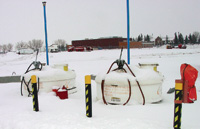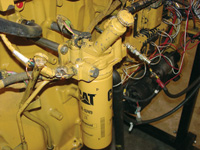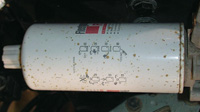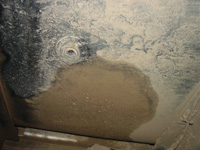
Equipment
Truck Checks: March 2010
It’s important to look at the problems with diesel fuel systems and the filtration needed.
ULSD (ultra low sulphur diesel) fuels are fuels with no more than 15 parts per million of sulphur content.
March 15, 2010
By Don Henry
It’s important to look at the problems with diesel fuel systems and the filtration needed.
ULSD (ultra low sulphur diesel) fuels are fuels with no more than 15 parts per million of sulphur content. LSD (low sulphur diesel fuel) are diesel fuels with no more than 500 parts per million of sulphur content. The move to ultra low sulphur content is to allow the application of newer emissions control technologies that should substantially lower emissions of particulate matter from diesel engines. These systems can greatly reduce emissions of oxides of nitrogen and particulate matter.
 |
|
| Photo 1. Typical diesel fuel tank. |
|
 |
|
| Photo 2. Above-ground fuel storage, note hand pumps |
|
 |
|
| Photo 3. Note hand pump to prime filters after a change. |
|
 |
|
| Photo 4. Note water drain trap on bottom of filter. |
|
 |
|
| Photo 5. Bottom of fuel tank; note drain. Photos by Don Henry |
This change to ULSD from LSD was to happen in Canada on Sept. 1, 2006, the same time as in California and one year before the rest of the U.S. for on-road applications. Up until this time, the acceptable maximum sulphur content was 500 ppm. To meet the 2007 emission standards, new fire apparatus are equipped with after-treatment exhaust components (see Truck Checks November 2009 at www.firefightingincanada.com). These new and expensive after-treatment devices cannot handle fuels with sulphur levels higher than 15 ppm. High sulphur levels can pollute the new exhaust devices. Even one tank of LSD fuel is estimated to be enough to ruin a system. So why would a person use LSD instead of ULSD?
What you might not know is that the concentration of sulphur in diesel fuel produced or imported for use in off-road engines shall not exceed 500 ppm from June 1, 2007, until May 31, 2010, and 15 ppm after that date. This means a farmer could buy and use LSD in a tractor. This fuel is often called marked farm fuel or purple diesel, depending on which part of the country you live in. Many municipalities, towns and cities have an exemption from the road tax that provincial and federal governments put on fuel and they use this cheaper marked fuel. It is OK, as long as the engine is in the town backhoe, snow blower or loader. It would be a big mistake to use this LSD diesel fuel in a 2007 or newer fire truck. You will quickly pollute the after-treatment devices. Use only ULSD on these trucks. And, to make sure you don’t make the mistake, use ULSD on all of your diesel-fuelled units.
■ Winter and summer diesel fuel
In Canada, it is necessary to have two types of diesel fuel. During the spring, summer and fall the fuel is called No. 2 diesel. The lighter, winter fuel is called No. 1 diesel fuel. For example, Esso will blend a lighter, winter diesel No. 1 from Oct. 22 to March 15, and a heavier, summer diesel from March 16 to Oct. 21. The main reason to blend this lighter fuel is to solve the cloud point problem. Summer diesel fuel will not flow in cold, winter temperatures. The temperature at which this happens is called the cloud point. To ensure that the fuel will flow, the oil refiners will either remove the paraffin wax that causes this problem from the fuel or blend in an additive to prevent the wax from gelling. Wax has a heat value when it burns. While it is true that summer diesel has more energy per pound than winter diesel, I believe it would be difficult to detect while simply driving. It may show up during a pump test and for that reason I would recommend that the annual fire pump test be conducted with a full tank of summer diesel.
Now, I know you are sitting back and thinking, does he not know we park our fire trucks inside during the winter? Many departments have an outside fuel storage; this can be very handy during a power failure such as those caused by ice storms. If your department buys its fuel locally, from a commercial fuel station, and you have an extended power outage, how are you going to get fuel for your trucks? If you use an outside storage facility, I strongly suggest that you fill these tanks with only a winter-grade diesel. You can always pump winter diesel in the summer but you cannot pump summer diesel in winter.
■ Cetane number
Cetane number, or CN, is a measurement of the combustion quality of diesel fuel during compression ignition. It is a significant expression of diesel fuel quality among a number of other measurements that determine overall diesel fuel quality.
The cetane number is a measure of the ease with which the fuel is ignited in the engine. It is most significant in relation to low-temperature startability, warm-up and smooth, even combustion. Fuels with a low cetane rating have high ignition lag that may cause an amount of fuel to collect in the combustion space before ignition occurs. High maximum cylinder pressures are reached and engine knocking results.
The cetane number of the fuel should meet the engine manufacturer’s minimum recommendation for the type of service. In North America, this number is normally at least 40. Most refineries ship diesel fuel with a 42 to 46 cetane rating. A cetane number higher than the required 42 does not dramatically improve engine efficiency or operation.
Fuels with high cetane ratings have low auto-ignition temperatures and hence are easier starting than fuels with low cetane ratings. This ease of starting is noticeable at cold temperatures – not a real problem for fire apparatus parked inside.
It is a common misconception that diesel fuels with high cetane ratings are more powerful and therefore burning this fuel will give you a more powerful truck.
I have heard it said that premium diesel may extend the life of the engine particulate filter. I cannot find any study that relates engine particulate filter plugging or the need for regeneration to a higher cetane level in the fuel.
Some fuel suppliers market their fuel as premium and it may have a higher cetane number. I am not a great believer in premium diesel fuel and, to my knowledge, there is no government standard that even defines premium diesel fuel in regards to a cetane number.
■ Fuel filters
There are normally two filters in a diesel fuel system, a primary and a secondary filter. These are often two separate housings or, in some cases, they are contained in one housing holding both filters.
The primary filter is the first filter downstream from the fuel tank but before the low-pressure fuel-transfer pump. The secondary filter is the last filter before the very expensive high-pressure, fuel-injection system.
This is no place to save a few dollars on substandard filters; buy what the manufacturer recommends and change them when recommended. Just because the guy at the auto parts store says it will fit does not mean it’s as good as the original.
It is not a best practice to fill the replacement filter with diesel fuel before installing it. This practice can allow contaminated fuel to get past the filter elements and flow downstream to the injectors. The reason for this practice was that it allowed the technician, in some cases, to not have to go through the time-consuming process of bleeding air from the fuel system after a filter change.
Many filters have water traps and, in some case, a water-in-fuel indicator.
If you do decide to change your own fuel filters, and it is not that difficult, then make sure you run the truck after the change to make sure you do not have any air in the fuel system.
An excellent, free interactive training CD is available from Baldwin Filter (number PKG475). It covers oil, coolant and fuel systems and their maintenance. Contact Jean Seitz at jseitz@baldwinfilter.com and note that you read my column on coolants and would like a copy of the CD.
■ Storage life
If diesel fuel is properly stored it is not unusual to get just one to two years of storage life from the fuel.
If you wish to extend this life it will be necessary to add a diesel fuel stabilizer. You may ask why the oil companies do not do that for you. About 95 per cent of all diesel fuel is consumed within two months of being produced. The fact that you wish to have your reserve truck sit for two or three years with the same fuel in the tank is not really a concern for the oil companies.
Fuel life can be extended if the fuel is stored with very little water in it. The ASTM 975 fuel test that is used at the refinery will allow up to .05 per cent water. In a 1,000-gallon fuel delivery, that would mean five gallons of water. This, of course, does not account for the water that may already be in the tanks from condensation.
Condensation in above-ground tanks is more of a problem than with underground tanks because of rapid changes in air temperature cause moist air to be drawn into the above-ground tanks. Take, for example, an above-ground fuel tank after a two- or three-day heat wave. A rain cloud could dump an inch or two of cooling rain on the tank; the fuel in the tank cools and contracts. This will cause the tank to draw moisture-laden air into the tank. Never try to use alcohol to remove this water. That trick works fine with gasoline fuels but does not work with diesel fuels. The alcohol will not mix with the diesel fuel and will only damage the engine injectors.
Water is very destructive to the fuel injectors and high-pressure injection pumps. But bacteria that can grow in fuel that has a high water content cause additional headaches. The byproducts of these little bugs can cause some real big problems. Their waste will plug the fuel filters with slime. It will often have a vinegary smell to it. It is possible to kill the bacteria with a bactericide made for diesel fuel systems. The problem is that now the dead bacteria will be transported to the filters and further plugging will occur. Bacteria grow best in warm conditions, with stale older fuel; they can be a problem in rural departments that do not use the truck as much as urban departments.
To detect water in gasoline or diesel fuels in below-ground or on-vehicle fuel tanks, a chemical strip can be used. It will change colour if there is water in the fuel. Go to www.Jamestowndistributors.com for an example of the test kit. If no water is being detected, then a routine, once-a-month check would be acceptable.
When a large amount of fuel is dumped into an underground tank it can stir up the water and sediments in the bottom of the tank. Now you know why some people, when they see a bulk tanker delivering fuel to their favourite gas station, often want to wait a day to fill up their own trucks.
The ASTM D227 oxidation stability test is a good indication of the expected life of a diesel fuel. This test measures how much sediment and gum will be deposited after keeping the fuel at 95 C in the presence of oxygen for 16 hours. It has been estimated that this roughly corresponds to one year of storage at 25 C.
A result of less than 20 mg/L of sediment and gum after the test is considered acceptable for normal diesel.
There is a very useful standard called NFPA 110 emergency and standby power systems. It contains a lot of good information.
Don Henry teaches the Automotive Services Technician and Heavy Equipment Technician programs at Lakeland College in Vermilion, Alta. He can be reached at don.henry@lakelandcollege.ca
Print this page